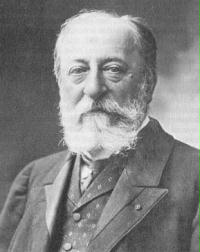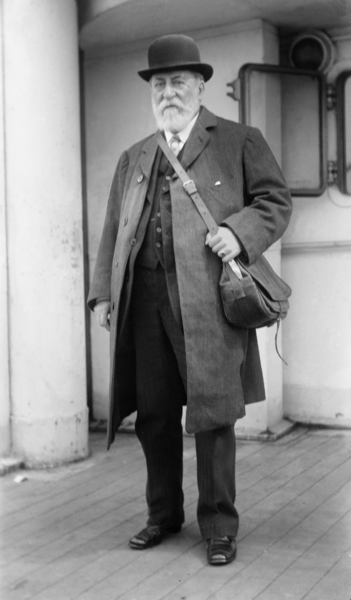<Back to Index>
- Chemist Hermann Emil Fischer, 1852
- Composer Camille Saint-Saëns, 1835
- King of France and of Navarre Charles X, 1757


Charles-Camille Saint-Saëns (9 October 1835 – 16 December 1921) was a French composer, organist, conductor, and pianist, known especially for The Carnival of the Animals, Danse macabre, Samson and Delilah, Piano Concerto No. 2, Havanaise, Introduction and Rondo capriccioso, and his Symphony No. 3 (Organ Symphony).
Saint-Saëns was born in Paris, France, on 9 October 1835, of Jewish descent. His father, a government clerk, died three months after his birth. His mother, Clémence, sought the assistance of her aunt, Charlotte Masson, who moved in. Masson introduced Saint-Saëns to the piano, and began giving him lessons on the instrument. At about this time, aged two, Saint-Saëns was found to possess perfect pitch. His first composition, a little piece for the piano dated 22 March 1839, is now kept in the Bibliothèque nationale de France. Saint-Saëns's precociousness was not limited to music. He learned to read and write by age three, and had some mastery of Latin by the age of seven. His first public concert appearance occurred when he was five years old, when he accompanied a Beethoven violin sonata. He went on to begin in-depth study of the full score of Don Giovanni. In 1842, Saint-Saëns began piano lessons with Camille-Marie Stamaty, a pupil of Friedrich Kalkbrenner, who had his students play the piano while resting their forearms on a bar situated in front of the keyboard, so that all the pianist's power came from the hand and fingers and not the arms. At ten years of age, Saint-Saëns gave his debut public recital at the Salle Pleyel, with a performance of Mozart's Piano Concerto No. 15 in B-flat major (K. 450), and various pieces by Handel, Kalkbrenner, Hummel, and Bach. As an encore, Saint-Saëns offered to play any of Beethoven's 32 piano sonatas from memory. Word of this incredible concert spread across Europe, and as far as the United States with an article in a Boston newspaper.
He then studied composition under Fromental Halévy at the Conservatoire de Paris. Saint-Saëns won many top prizes and gained a reputation that resulted in his introduction to Franz Liszt, who would become one of his closest friends. At the age of sixteen, Saint-Saëns wrote his first symphony; his second, published as Symphony No. 1 in E-flat major, was performed in 1853 to the astonishment of many critics and fellow composers. Hector Berlioz, who also became a good friend, famously remarked, Il sait tout, mais il manque d'inexpérience ("He knows everything, but lacks inexperience"). For income, Saint-Saëns played the organ at various churches in Paris, with his first appointment being at the Saint-Merri in the Beaubourg area. In 1857, he replaced Lefébure-Wely at the eminent position of organist at the Église de la Madeleine, which he kept until 1877. His weekly improvisations stunned the Parisian public and earned Liszt's 1866 observation that Saint-Saëns was the greatest organist in the world. From
1861 to 1865, Saint-Saëns held his only teaching position as
professor of piano at the École Niedermeyer, where he raised
eyebrows by including contemporary music — Liszt, Gounod, Schumann, Berlioz, and Wagner — along
with the school's otherwise conservative curriculum of Bach and Mozart.
His most successful students at the Niedermeyer were André Messager and Gabriel Fauré, who was Saint-Saëns's favourite pupil and soon his closest friend. Saint-Saëns was a multi-faceted intellectual. From an early age, he studied geology, archaeology, botany, and lepidoptery. He was an expert at mathematics.
Later, in addition to composing, performing, and writing musical
criticism, he held discussions with Europe's finest scientists and
wrote scholarly articles on acoustics, occult sciences, Roman theatre decoration, and ancient instruments. He wrote a philosophical work, Problèmes et mystères, which spoke of science and art replacing religion; Saint-Saëns's pessimistic and atheistic ideas foreshadowed Existentialism. Other literary achievements included Rimes familières, a volume of poetry, and La crampe des écrivains, a successful farcical play. He was also a member of the Astronomical Society of France; he gave lectures on mirages, had a telescope made to his own specifications, and even planned concerts to correspond to astronomical events such as solar eclipses. In 1870, the Franco-Prussian War,
despite being over in barely six months, left an indelible mark on the
composer. He was relieved from fighting duty as one of the favourites
of a relative of emperor Napoleon III, but fled nonetheless to London for several months when the Paris Commune broke
out in the besieged Paris of winter 1871, his fame and societal status
posing a threat to his survival. In the same year, he co-founded with Romain Bussine the Société Nationale de Musique in
order to promote a new and specifically French music. After the fall of
the Paris Commune, the Society premiered works by members such as
Fauré, César Franck, Édouard Lalo,
and Saint-Saëns himself, who served as the society's co-president.
In this way, Saint-Saëns became a powerful figure in shaping the
future of French music. In
1875, Saint-Saëns married Marie-Laure Truffot and they had two
children, André and Jean-François, who died within six
weeks of each other in 1878. Saint-Saëns left his wife three years
later. The two never divorced, but lived the rest of their lives apart
from one another. In 1886 Saint-Saëns debuted two of his most renowned compositions: The Carnival of the Animals and Symphony No. 3, dedicated to Franz Liszt, who died that year. That same year, however, Vincent d'Indy and
his allies had Saint-Saëns removed from the Société
Nationale de Musique. Two years later, Saint-Saëns's mother died,
driving the mourning composer away from France to the Canary Islands under
the alias "Sannois". Over the next several years he travelled around
the world, visiting exotic locations in Europe, North Africa, Southeast Asia, and South America. Saint-Saëns chronicled his travels in many popular books using his nom de plume, Sannois. In 1908, he had the distinction of being the first celebrated composer to write a musical score to a motion picture, The Assassination of the Duke of Guise (L'assassinat du duc de Guise),
directed by Charles Le Bargy and André Calmettes, adapted by
Henri Lavedan, featuring actors of the Comédie Française.
It was 18 minutes long, a considerable run time for the day. In 1915, Saint-Saëns traveled to San Francisco, California and guest conducted the San Francisco Symphony Orchestra during the Panama-Pacific International Exposition, one of two world's fairs celebrating the completion of the Panama Canal. Saint-Saëns
continued to write on musical, scientific and historical topics,
travelling frequently before spending his last years in Algiers, Algeria. In recognition of his accomplishments, the government of France awarded him the Légion d'honneur. Saint-Saëns died of pneumonia on 16 December 1921 at the Hôtel de l'Oasis in Algiers. His body was repatriated to Paris, honoured by state funeral at La Madeleine, and interred at Cimetière du Montparnasse in Paris. Saint-Saëns was either friend or enemy to some of Europe's most distinguished musicians. He stayed close to Franz Liszt and maintained a fast friendship with his pupil Gabriel Fauré, who replaced him as organist and choirmaster when he retired. Additionally, he was a teacher and friend to Isidor Philipp,
who headed the piano department at the Paris Conservatory for several
decades and was a composer and editor of the music of many composers.
But despite his strong advocacy of French music, Saint-Saëns
openly despised many of his fellow-composers in France such as Franck, d'Indy, and Massenet. Saint-Saëns also hated the music of Claude Debussy; he is reported to have told Pierre Lalo, music critic, and son of composer Édouard Lalo, "I have stayed in Paris to speak ill of Pelléas et Mélisande."
The personal animosity was mutual; Debussy quipped: "I have a horror of
sentimentality, and I cannot forget that its name is Saint-Saëns."
On other occasions, however, Debussy acknowledged an admiration for
Saint-Saëns's musical talents. Saint-Saëns had been an early champion of Richard Wagner's music in France, teaching his pieces during his tenure at the École Niedermeyer and premiering the March from Tannhäuser. He had stunned even Wagner himself when he sight-read the entire orchestral scores of Lohengrin, Tristan und Isolde, and Siegfried, prompting Hans von Bülow to
refer to him as, "the greatest musical mind" of the era. However,
despite admitting appreciation for the power of Wagner's work,
Saint-Saëns defiantly stated that he was not an aficionado. In 1886, Saint-Saëns was punished for some particularly harsh and anti-German comments on the Paris production of Lohengrin by
losing engagements and receiving negative reviews throughout Germany.
Later, after World War I, Saint-Saëns angered both French and
Germans with his inflammatory articles entitled Germanophilie, which ruthlessly attacked Wagner. Saint-Saëns edited Jean-Philippe Rameau's Pièces de clavecin, and published them in 1895 through Durand in Paris (re-printed by Dover in 1993). On 29 May 1913, Saint-Saëns stormed out of the première of Igor Stravinsky's Le sacre du printemps (The Rite of Spring), allegedly infuriated over what he considered the misuse of the bassoon in the ballet's opening bars.